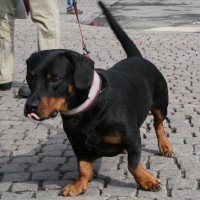Appearance of the Dachsweiler
|
| The Dachsweiler can vary in appearance even within a single litter. Some puppies have grown to resemble the Rottweiler with a muscular, powerful body, but still have the shorter legs of the Dachshund. Other puppies may resemble the Dachshund with its long body, short legs and dormant body, but may have a head like a Rottweiler. The Dachsweiler is a hybrid dog whose exact description is difficult to determine. Their defined head with long, well-developed muzzle, short but powerful legs, long sturdy tails that extend directly from the spine, deep chest and great lung capacity highlight a dog built for action. Some dogs will have paddle-like legs thanks to their Dachshund parent, while others will have firm, rounded paws like their Rottweiler parent. Their ears are likely to be long and floppy, while their eyes are dark and almond-shaped, with a curious glint. The long body and back is the Dachshund's true trademark and part of its broad appeal. |
Temperament of the Dachsweiler
|
| The Dachsweiler line comes from dogs with a strong instinct to hunt, stalk and, in the case of the Dachshund, kill their prey. These instincts will be passed on in part to your Dachsweiler, with a personality that's even tempered, courageous, confident and with a touch of stubbornness. They are not for the inexperienced owner, for if he is not taught to respect his owner and accept him as pack leader, the dog can become a calamity. This problem can then see the Dachsweiler become destructive, disobedient and a dog that will defy all your commands. But if you're a solid owner, then once this dog is socialized and trained, it will be one of the most reliable, gentle and affectionate dogs around. They can be good as family dogs, protectors of family members. They will even accept cats and other pets, if they have been well socialized and the owner has authority over them. They are deep thinkers, gauging situations before reacting. They can also become barkers unless trained. With the right training, socialization and a solid owner, these are loving, funny, active and adorable dogs. |
Needs and activities of the Dachsweiler
|
| The Dachsweiler's family history includes both parent breeds as active dogs, so the hybrid Dachsweiler will be similar to them. They need a daily walk or stimulating games at home to help them burn off some of their energy. Their longer bodies can be prone to back injuries, even when jumping out of bed. When holding your dog, be sure to support the back and rear. Obedience training and socialization should start when your dog is young. Keep your dog on a leash until he is well trained and socialized, as he may show aggression towards other dogs of the same sex. Dachsweilers can learn anything if they receive proper training and lavish praise and rewards for their efforts. They do best in a home with a secure yard and adapt easily to most climates. |
Maintenance of the Dachsweiler
|
| The Dachsweiler is a low-maintenance dog, unless it has the longer coat or stiff coat of some Dachshund breeds. For the short, smooth coat, weekly brushing, rubbing with a damp cloth and general maintenance tasks such as nail trimming and tooth brushing are all that's needed. For longer or stiffer coats, more brushing is needed to remove fallen hairs and avoid matting. They don't need to bathe all the time, just when necessary. This practice will keep the coat in good condition. Because they have floppy ears, take care to clean the inside of the ear to avoid debris build-up and look for any infection, which is often inflamed and smelly. If you get your Dachsweiler used to the grooming routine, it will be easier for the vet to handle him if you need to visit. Grooming is valuable bonding time with your dog and a chance to check for cuts, sores or parasites such as ticks or fleas. |









 English (United Kingdom)
English (United Kingdom)